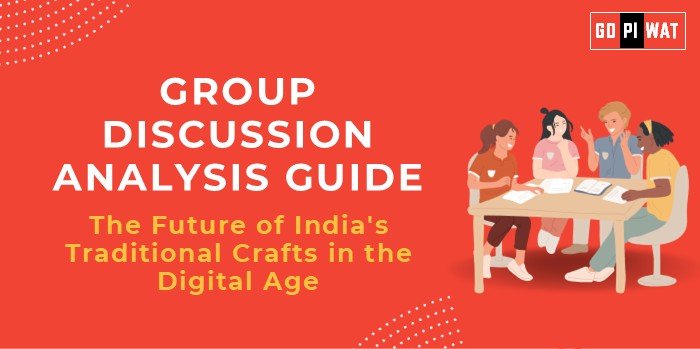🌟 Group Discussion (GD) Analysis Guide
The Future of India’s Traditional Crafts in the Digital Age
📖 Introduction to the Topic
Opening Context: “India’s traditional crafts, renowned for their heritage and craftsmanship, face both unprecedented challenges and opportunities in the digital era. The integration of technology offers the chance to preserve and promote these crafts globally while addressing structural inefficiencies.”
Topic Background: Traditional crafts in India are vital to the country’s cultural identity and economy, employing over 7 million artisans. However, challenges like market access and skill gaps hinder their sustainability. The digital age brings tools such as e-commerce and digital marketing, presenting a unique chance for reinvention.
📊 Quick Facts and Key Statistics
- Artisan Workforce: 7 million artisans contribute to 5% of India’s GDP.
- E-Commerce Growth: India’s e-commerce market is expected to reach $120 billion by 2026.
- Government Initiatives: ₹4,000 crore allocated to “Crafts India” under the Digital India initiative.
- Export Value: Traditional crafts exports amounted to $3.8 billion in 2023.
- Social Media Impact: Over 60% of artisan entrepreneurs report increased visibility through platforms like Instagram.
👥 Stakeholders and Their Roles
- Government: Policy support and funding for digital literacy and market access.
- Private Sector: E-commerce platforms enabling global reach and scaling operations.
- Artisans and Cooperatives: Driving creative production and embracing digital tools.
- Consumers: Advocating for sustainability and cultural preservation.
- NGOs: Facilitating skill development and providing financial assistance.
✅ Achievements and Challenges
Achievements:
- Increased global reach through platforms like Amazon Karigar and GoCoop.
- Digital skill programs such as PMGDISHA trained 50,000 artisans in 2023.
- Heritage recognition through GI tagging for crafts like Banarasi sarees.
Challenges:
- Digital divide: Only 20% of rural artisans have stable internet access.
- Cost barriers: High transaction fees on e-commerce platforms reduce profits.
- Skill gaps: Limited exposure to digital marketing and logistics management.
🌏 Global Comparisons
- China: Government subsidies and Taobao Villages accelerate rural craft digitization.
- Indonesia: Collaborative hubs like Kriya boosted craft exports by 30%.
📌 Case Studies:
- Rajasthan’s Handicrafts Hub: Enabled ₹500 crore in exports through digital initiatives.
- Kerala’s Weavers Digital Network: Reduced distribution costs by 40%.
💬 Structured Arguments for Discussion
- Supporting Stance: “The digital age has democratized access to global markets, enabling artisans to directly connect with buyers.”
- Opposing Stance: “Technology adoption alone cannot solve systemic issues like poor infrastructure and low literacy rates.”
- Balanced Perspective: “While digital tools enhance market access, comprehensive support is crucial for sustained impact.”
🚀 Effective Discussion Approaches
- Opening Approaches:
- Cite the rise of e-commerce and its potential for crafts.
- Highlight traditional crafts’ contribution to India’s cultural diplomacy.
- Counter-Argument Handling:
- Challenge: “Craft authenticity may be diluted through mass production.”
- Rebuttal: “Blockchain technology ensures authenticity and traceability.”
🛠️ Strategic Analysis (SWOT)
- Strengths: Rich heritage, increasing global demand, government support.
- Weaknesses: Digital illiteracy, inadequate infrastructure.
- Opportunities: E-commerce expansion, tourism revival post-pandemic.
- Threats: Competition from machine-made products, data privacy concerns.
🎓 Connecting with B-School Applications
- Real-World Applications: Exploring supply chain optimization, market analysis, and social entrepreneurship projects related to crafts.
- Sample Interview Questions:
- “How can digital marketing enhance artisan entrepreneurship?”
- “Evaluate the economic potential of India’s craft sector in the digital age.”
- Insights for Students: Sustainability strategies, brand management of heritage products, global trade analysis.


